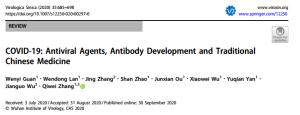-

-
Name Original indication Target Clinical trials reported Dose/administration Toxicities/side effects Western medicine Remdesivir Ebola virus disease (Phase II); RNA-dependent RNA polymerase inhibitor Yes A 10-day course of remdesivir treatment, 200 mg intravenously on day 1, 100 mg for next 9 days None noted (similar to placebo in severe COVID patients) Chloroquine/Hydroxychloroquine Malaria treatment Caps hemozoin to prevent biocrystallization of heme, PLpro inhibitor Yes Chloroquine: 500 mg daily for 10 days
HCQ: weight > 50 kg, 500 mg × 2/d for 7 days; weight < 50 kg, 500 mg × 2/d on days 1 ~ 2, 500 mg/d on days 3 ~ 7;Hemolytic anemia, cardiomyopathy, neutropenia, GI disturbances, retinopathy, rash, QT prolongation Lopinavir/ritonavir A fixed dose combination for HIV/AID treatment Lopinavir: protease inhibitor
Ritonavir: protease inhibitor and inhibitor of CYP3A4Yes Oral, 400 mg/100 mg, twice daily QT prolongation, CV events, dyslipidemia, liver injury, GI disturbances Arbidol Influenza treatment Inhibits viral entry by interfering with clathrin-dependent trafficking Yes 200 mg × 3/d for no more than 10 d No significant differences between ARB-treated and control groups Teicoplanin A glycopeptide antibiotic to treat bacterial infection Inhibits viral entry by inhibiting the activity of cathepsin L No does not have dose-related adverse effects in the dose range 3–10 mg/kg Glycyrrhizic Acid An extract of a traditional Chinese herb to treat coughs, colds and disturbed digestion Regulate immune function, can bind to ACE2 Yes 250 mg standardized extract (25% Glycyrrhizin—62.5 mg) for 10 days mild hypertension, cytotoxicity and bone damage Darunavir A fixed dose combination for HIV/AID treatment 3CL protease inhibitor, substrate of CYP3A4 Yes 800 mg/days Liver injury, dyslipidemia, sulfonamide allergy Forsythin and Chlorogenic acid Extract of a traditional Chinese herb to treat influenza ACE2 inhibitor No Tocilizumab Commonly used for rheumatoid arthritis (RA) and cytokine-release syndrome induced by chimeric antigen receptor-T cell therapy FCGR3A, IL6R, CD69, GALNT18 Yes 4–8 mg/kg body weight Thrombocytopenia, liver injury, neutropenia, rash, hypertension, infection Interferon beta-1b Pharmacogenomics determinants are not well-delineated for IFN-β1b Yes 8 million IU (0.25 mg) on alternate days Liver injury, depression, heart failure, leukopenia, and flu-like symptoms, etc. Dexamethasone First-line treatment for immune-related complications Suppresses the immune system by inhibiting naive T cell proliferation and differentiation Yes 6 mg once daily for 10 days Mild increase of blood glucose level, ocular hypertension, and cataract, mood and behavior change, osteoporosis Traditional Chinese medicine Qingfei Paidu Decoction A traditional Chinese medicine for treating exogenous fever caused by cold evil The network pharmacology analysis showed that QPD has an overall regulatory effect via multi-component and multi-target Yes Qingfei dayuan granules & Chaihu daxiong mixture For COVID-19 patients with severe cough, sputum, and wheezing No Huashi Baidu Granules First approval drug of traditional Chinese medicine for the clinical treatment of COVID-19 Eliminate inflammation, improve immunity Yes Lianhuaqingwen As traditional Chinese medicine formula to treat influenza Inhibits the SARS-COV-2 replication, affects virus morphology and exerts anti-inflammatory activity in vitro Yes 4 capsules, 3 times a day, after meal No toxic side effects in mice The information is retrieved from the Chinese Clinical Trial Registry (http://www.chictr.org.cn/index.aspx) and Clinicaltrials.gov as of May 27th, 2020. Table 1. Chemical drugs in clinical registrations to treat COVID-19.
Figure 1 个
Table 1 个